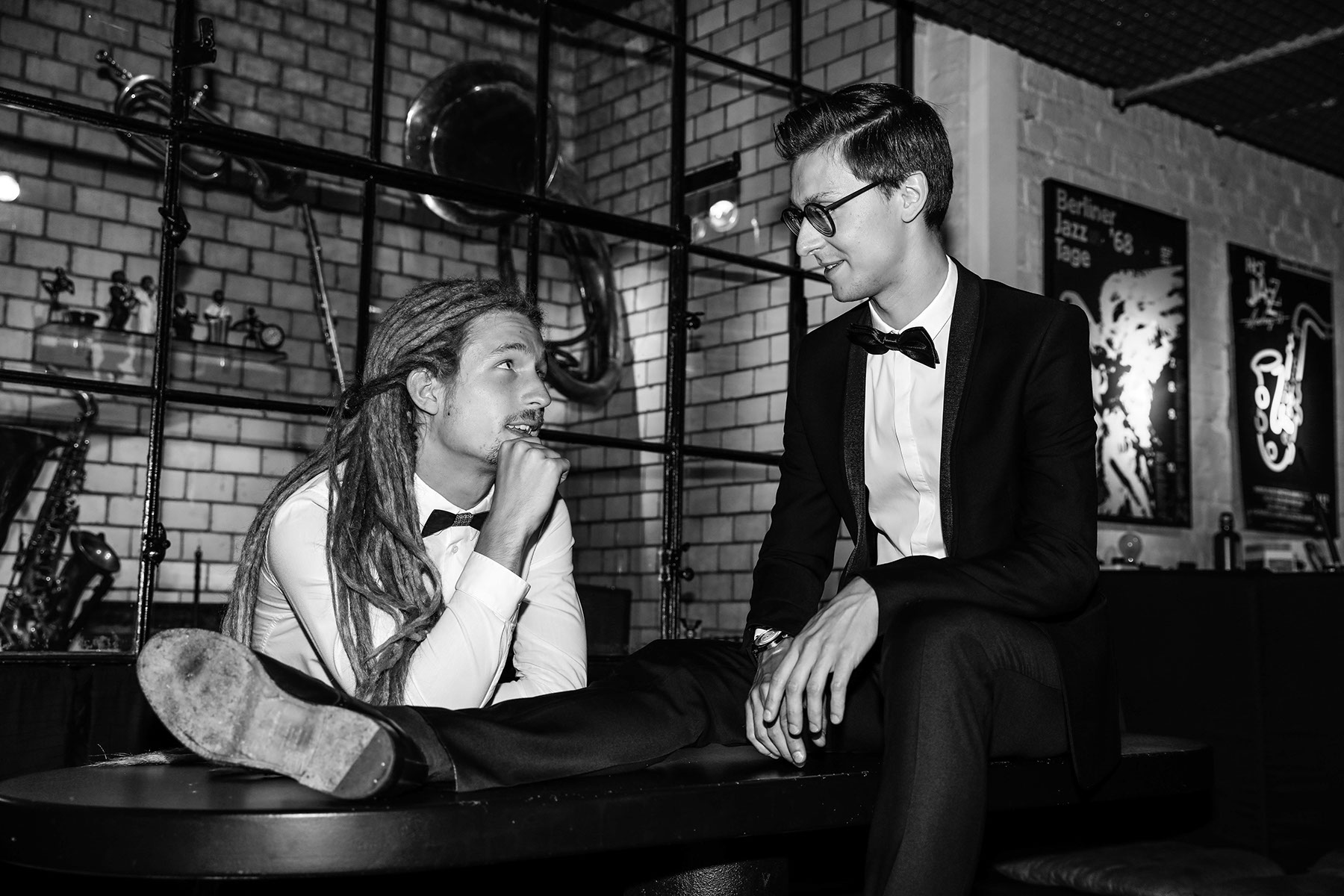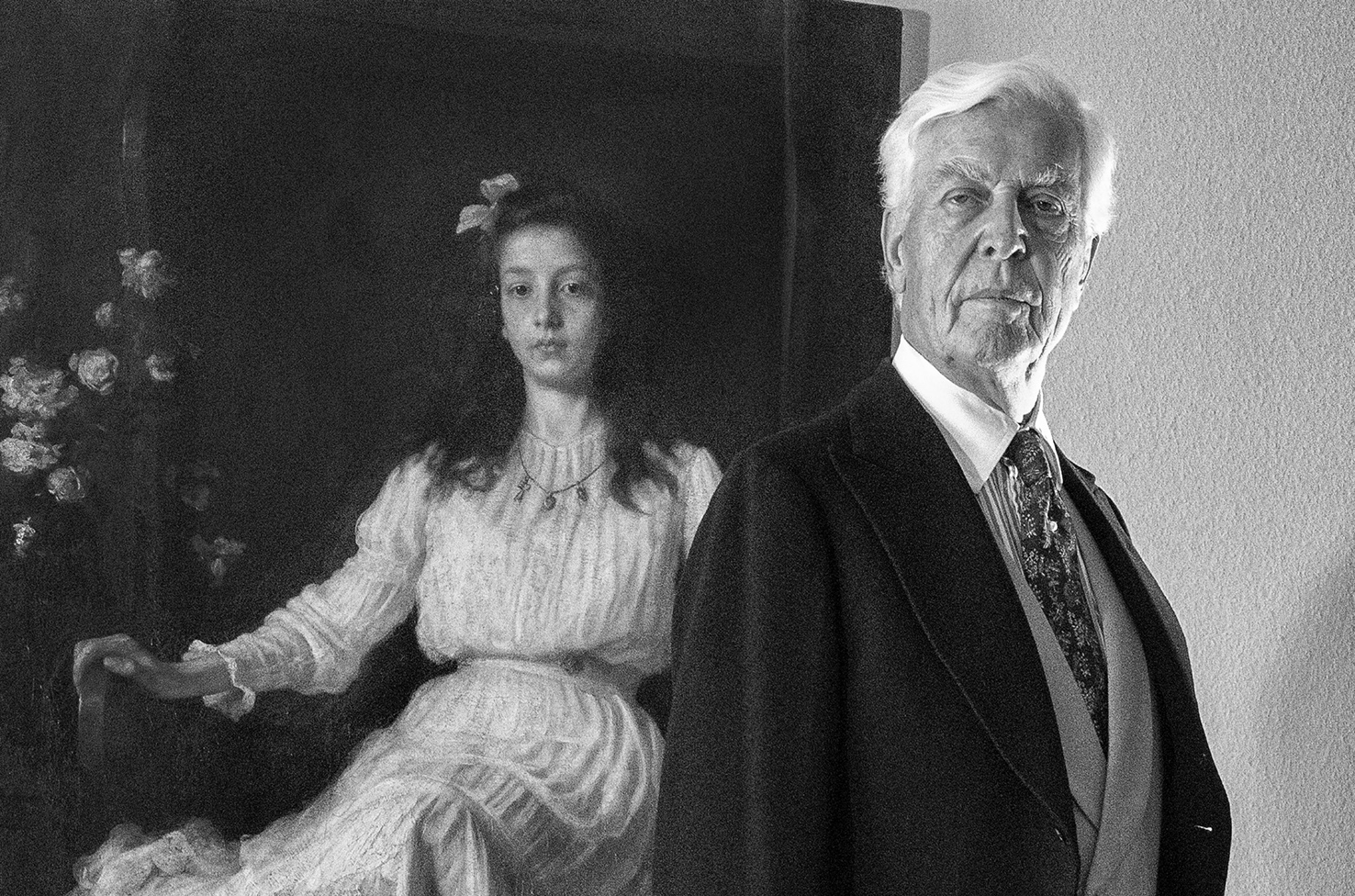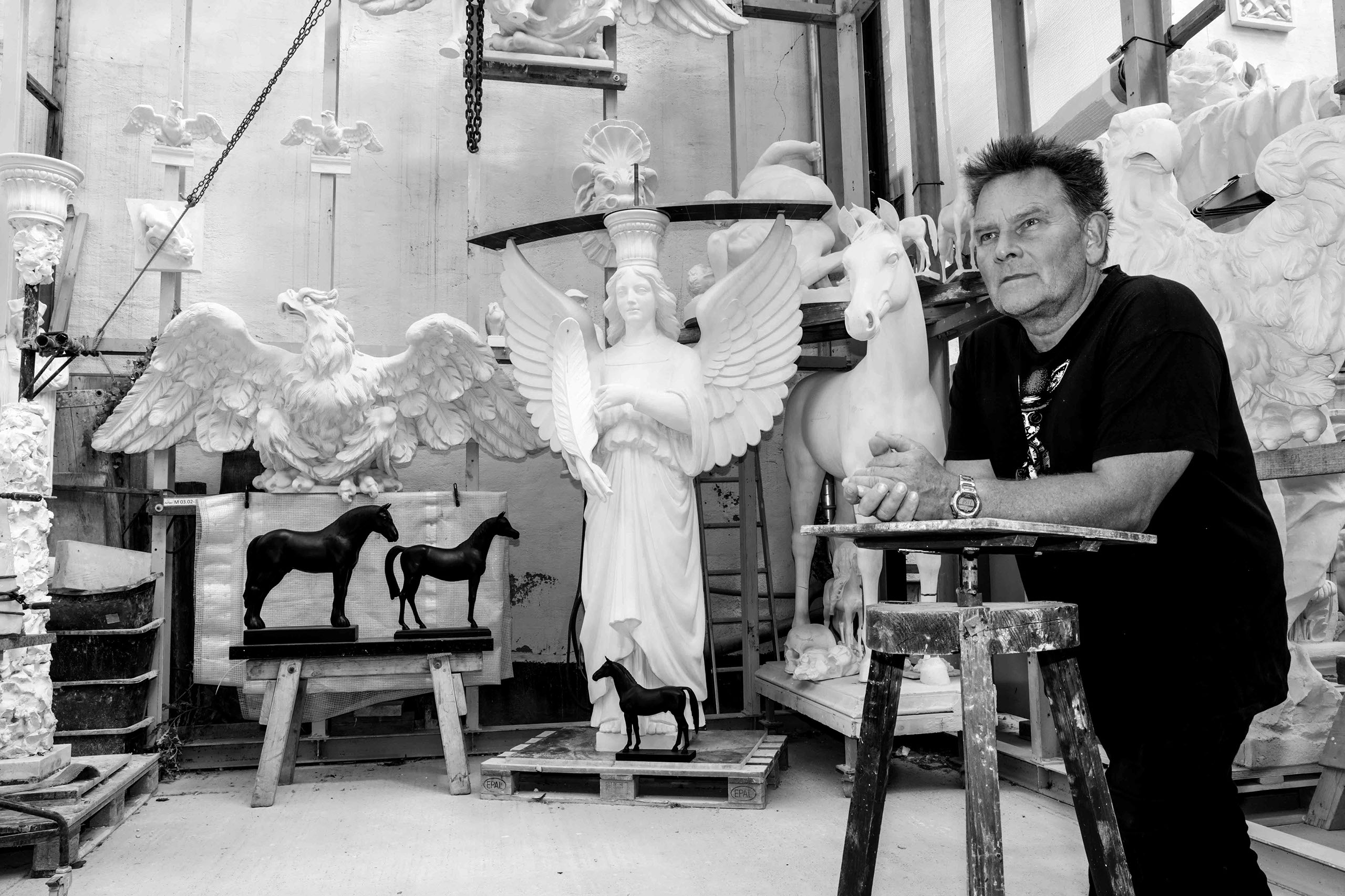RICARDO
VON
BRASCH
Musiker Tänzer Artisten Bildhauer Maler und Schauspieler in der Porträtfotografie von Ricardo von Brasch
Ricardo v. Brasch bringt sein Erfolgsprojekt KÜNSTLER TREFFEN IN BERLIN in erweiterter Form und in Doppelfunktion als Porträtfotograf und kreativer Ausstellungsmacher in einen festlichen Rahmen.
Jungen, außergewöhnlich begabten Künstlern soll die Gelegenheit gegeben werden, in der Öffentlichkeit in Verbindung mit etablierten Vertretern der Kulturszene der Hauptstadt wahrgenommen zu werden.
In einer modernen Eventlocation hinter historischer Fassade sollen im kommenden Jahr Kreative aus ganz unterschiedlichen Richtungen für eine gleichzeitige Wahrnehmung einer interdisziplinären Anordnung von Kunst sorgen: Fotografie, Malerei, Skulptur, Schauspiel, Tanz, Artistik, Mode, Musik. Gleichzeitig ein multikultureller Querschnitt und ein Längsschnitt in die europäische Kulturgeschichte. Dieses Zusammenkommen so unterschiedlicher Aspekte, diese besondere Form der Synästhesie, diese Faszination des Kunstortes Berlin ist die Inspiration für dieses Projekt.
Das Konzept von
KÜNSTLER TREFFEN II
beruht auf zwei Säulen:
Säule 1 bilden die jungen Künstler.
Säule 2 bilden die etablierten Kulturspitzen.
Beide Gruppen haben unterschiedliche Aufgaben
Ein Procedere pflegen:
Zu Säule 1: Auch diesmal wird jeder Künstler fotografisch porträtiert. Den Künstler kostet dies nichts und er bekommt zudem alle Nutzungsrechte an den Fotos uneingeschränkt zur Verfügung gestellt. Kostümbildner und Visagisten aus Mode, Film, TV sorgen gemeinsam mit Ricardo v. Brasch für die richtige Szene für die Fotos (1,50 x 2,00 Meter große Bilder).
Von den Kreativen wird eine Performance bei der Vernissage erwartet.
Zu Säule 2: Die etablierten Kulturspitzen erhalten ihre Bilder gratis. Sie haben keine weiteren Verpflichtungen außerhalb ihrer persönlichen Ansprache von fünfzehn Minuten bei dem Ausstellungs-Event, die wahlweise durch eine Video-Grußbotschaft ersetzt werden kann.

Ein kleiner Rückblick:
Beim Künstlertreffen vor zehn Jahren porträtierte Ricardo v. Brasch zweihundert Maler in Berlin und überließ ihnen auch kostenfrei die Rechte an diesen Profifotos. In jenen Jahren ungewöhnlich, versammelte v. Brasch Künstler aus Ost und West zudem in einem Fotoband. Damals wirkte noch eine rigide Trennung zwischen abstrakter Westkunst und figurativer Ostkunst. Manche Westkünstler widerriefen sogar ihre Teilnahme. Ricardo v. Brasch gelang es aber, mit seiner Vision zu überzeugen, dass sowohl die Zukunft der Berliner Kunst als auch ihre Gegenwart eine internationale Mischung war und sein würde.
Diese bahnbrechende Ausstellung mit anschließender, klassischer Verlagsveröffentlichung fand damals in Clärchens Ballhaus statt. Viele der Porträtierten sind heute Lehrkräfte an der renommierten Universität der Künste Berlin. Einige wurden durch die Ausstellung in der Auguststraße in Berlin-Mitte entdeckt (Ricardo von Brasch, KÜNSTLER TREFFEN IN BERLIN, Prestel Verlag, München 2008).
Ein neues Thema setzen:
In Berlin gibt es einen weit gefassten, energetischen Kunstgeist, der fasziniert, auf die ganze Stadt abfärbt und auch junge Kreative aus aller Welt magnetisch anzieht. Wo sonst als in dieser Stadt könnte die Suche nach dem Mozart und dem Dürer von heute schöner fortgesetzt werden? Vielleicht helfen auch die aufgeklärt-freigeistigen, barock-lebensfrohen, aber auch kritisch-modernen Geister des Ortes ein wenig dabei, die Besten der Kunstszene wieder für die freie Kunst zu begeistern?!
Eine Bühne für außergewöhnliche Talente schaffen:
Immer steht zu befürchten, dass die mathematisch, musisch, visuell, kurz: die künstlerisch außergewöhnlich Begabten in die IT Branche abwandern, oder in Banken
und Industriekonzernen neue Produkte entwickeln und der künstlerischen Basisproduktion keinen Raum mehr geben, und zwar allein, um ihre Existenz nicht zu
gefährden. Viele verdienen ihr Geld, indem sie sich nur noch mathematisch engagieren, ihre musischen und visuellen Begabungen kommen dann nicht mehr zum Zug.
Außergewöhnliche, überdurchschnittliche Talente und auch Hochbegabte werden aber in ihrer ganzen weitreichenden Kreativität gebraucht, und zwar nicht nur für die
Kunst, sondern für die gesellschaftliche Entwicklung. Bei den wenigen Begabten, die soziale Abwertung als Künstler in Kauf nehmen, soll dieses Projekt auch eine
Möglichkeit bieten, Förderung einzuleiten.
Anders als im üblichen Kunstbetrieb wird es bei dieser Veranstaltung keine Auflagen geben, sondern jeder Künstler entscheidet selbst, welches zum Beispiel von ihm
komponierte Musikstück zur Aufführung kommt. Es wird dann im Wechsel mit den etablierten Kulturspitzen in fünfzehn minütigen Performances auf zwei Bühnen
vorgestellt.
Kulturträger dieser Stadt, weltbekannte Musiker, Stiftungsgründer, Sammlerehepaare, Architekten und Bauherren, Netzwerker und begeisterte Freunde künstlerischen
Schaffens sind diejenigen, die hier für Aufmerksamkeit für die außergewöhnlichen Talente sorgen möchten. Diese etablierten Kulturspitzen, die in Berlin Impulse
setzten, sollen in ihren fünfzehn Minuten darüber sprechen, welche Passion sie erfüllte, mit den Widrigkeiten des Künstlerlebens umzugehen.
Einen Seelenarzt als Seelenfotografen erleben:
Die Bilder drücken die Beziehung zwischen dem Fotografiertem und dem Fotografen aus.
Nur die seelische Resonanz kann dazu führen, dass ein gutes Porträt entsteht. Diesen Effekt bezeichnet Ricardo v. Brasch als „Transpersonalen Realismus“. Den Flow zwischen dem Künstler und seinem Werk ins Licht zu setzen ist das Ziel seiner fotografischen Arbeit. Es geht v. Brasch darum, die seelische Landschaft eines Menschen über seine Persona, über seine Fassade hinaus in ihrer einzigartigen Individualität nicht nur zu lesen und zu erfassen, sondern visuell für den Betrachter erfahrbar zu machen.
Eine Ausstellung gestalten:
Was sehen Sie? Herrliche, lichtdurchflutete Räume mit großen Bildern: Die Künstlerporträts. In den Räumen verteilt: Skulpturen der Bildhauer. Zwei Bühnen mit Musik und Unterhaltung.
Bei der Vernissage wird es die seltene Gelegenheit für die Gäste geben, die jungen sowie die etablierten Künstler nicht nur auf der Bühne zu bewundern, sondern sie auch persönlich kennen zu lernen, spannende Gespräche zu führen und gemeinsam die neue Kunst zu feiern!
Ein Fotopapier als Basis einer kreativen Familientradition:
Nach über dreißigjähriger Tätigkeit als Nervenarzt und Psychoanalytiker begann Ricardo v. Brasch ein neues Leben als Porträtfotograf. Er wurde 1946 nahe Osnabrück in Deutschland geboren, an dem Ort, wo seine Vorfahren seit 1895 Fotobasispapier produzierten. Noch heute ist die Firma Schoeller weltweit tätig im Bereich der Spezialpapiere. Seine Mutter Maina von Brasch-Schoeller war eine bekannte und mit vielen Preisen ausgezeichnete Landschaftsfotografin. Sie war eine Schülerin von Liselotte Strelow, bei der auch ihr Sohn in jungen Jahren als Praktikant arbeitete.
Ricardo v. Brasch erlernte zunächst Bildhauerei und studierte danach Medizin und Indologie an der Universität Würzburg sowie im indischen Benares.
Gemeinsam mit seiner Frau Nicoline gründete er im Schwarzwald eine eigene Akutklinik für Psychosomatik und Psychotherapie, in der er lange als Chefarzt wirkte.
In Freiburg und Berlin unterzog er sich einer professionellen Ausbildung in Porträtfotografie.
www.ricardo-von-brasch.de
-> All about our project
ARTISTS GETTING TOGETHER II
The concept behind KÜNSTLER TREFFEN II rests on two cornerstones: Cornerstone 1 is made up of the young artists themselves.
Cornerstone 2 is made up of the established representatives of cultural life. Each group will have differing tasks.
The modus operandi will be as follows:
Cornerstone 1: As in the event’s past iteration, each artist will be represented by a photographic portrait. The photos will be taken free of charge to the artist and he/she will receive unrestricted usage rights to the images. Costume designers and makeup artists from fashion, film and TV, working under Ricardo von Brasch, will help create an optimal composition for each portrait (1.50 x 2.00 meters).
Each creative talent is expected to deliver a performance at the vernissage.
Cornerstone 2: The established personalities of cultural life will also receive their portraits free of charge. They will have no further obligation other than to give a personal, fifteen- minute address at the exhibition event, which can also be replaced by a videotaped greeting if they so desire.
A quick look back:
As part of the Kunstler Treffen project held ten years ago, Ricardo von Brasch took portrait photos of two hundred painters in Berlin, granting them the rights to these professional- quality photos free of charge. In the process, von Brasch broke new ground by bringing artists from East and West Germany together in one photo album. This went against the grain, for it was still usual in those days to draw a rigid demarcation between the abstract art typical of the West and the figurative art created in the East. Some of the invited West German artists actually refused to be a part of the project for this reason. Nevertheless, Ricardo von Brasch was able to make his vision a compelling reality and to show that the Berlin art scene has always consisted of a cosmopolitan mixture and will continue to do so in the future.
This pioneering exhibition, along with the more traditional reception in the form of a catalogue, were held at Clärchens Ballhaus, on Auguststrasse in the Mitte district, one of Berlin’shistoricdance-hallrestaurants. Manyoftheartistsfeaturedintheportraitshave
since become teachers at the prestigious Berlin University of the Arts. Some of them were actually discovered as a consequence of the exhibition itself. (Ricardo von Brasch, KÜNSTLER TREFFEN IN BERLIN, Prestel Verlag, Munich, 2008).
Setting a new theme:
Berlin boasts a hugely diverse, dynamic, and fascinating artistic climate that rubs off on the entire metropolis and that exerts a magnetic attraction on young creative talent from all over the world. What other city provides a more conducive environment for identifying a new Mozart or Dürer? Could its many enlightened free spirits, with their Baroque joie de vivre and critical, modern viewpoint, not help to reawaken enthusiasm for independent creative expression among the art scene’s best and brightest?!
Providing a stage for exceptional talent:
It is a regrettable fact that those endowed with unusual gifts in mathematics or in the fine and visual arts, i.e. the artistically gifted and talented, are often lost to the IT, banking or corporate sector, where they are put to work developing new products to the exclusion of any original artistic creativity. And this only because they are afraid of not being able to make a living from art. Many earn their livelihoods by concentrating exclusively on mathematical pursuits, thereby leaving their musical and visual talents untapped. This is a shame, for exceptional, above-average talents, as well as truly brilliant ones, should be able to develop the full range of their creativity, not just for the sake of art, but also for the good of society as a whole. The project is intended to help not only these stymied artists, but also those bold few who have decided to brave the social obstacles faced by those who devote themselves fully to art, assisting them in finding grants or sponsors.
Contrary to normal practice in the art world, participation in this event will not be subject to strict preconditions. Rather, each artist will be free to select the work with which he or she wishes to participate (e.g. from among his/her musical compositions). The work will then be presented on two stages in fifteen-minute performances, which will alternate with the speeches given by the already established “cultural A-listers.” The latter group will comprise representatives of the city’s cultural organizations, world-famous musicians, endowment founders, collector couples, architects, developers, and other art aficionados, whose presence will help draw attention to the exceptional talent being showcased. Each of these established cultural multipliers, who help the set the agenda on the Berlin art scene, will hold fifteen-minute talks on the passion that motivated them to face the adversities that come with an artistic career.
Experiencing a healer as a photographer of the soul:
Each exhibited portrait photo is intended to express a distinct relationship between the subject and the photographer. After all, a certain spiritual connection and rapport – what Ricardo von Brasch refers to as “transpersonal realism” – is indispensable for the creation of any effective portrait. Capturing the “flow” between each artist and his/her work is what von Brasch regards as the prime focal point of his photography. What matters most to him is not just to “read” and capture a person’s spiritual landscape, in all its unique individuality, by penetrating to the inner persona behind the façade – he also intends to make that landscape visually accessible to the viewer.
Designing an exhibition:
Visitors will be greeted by magnificent, light-flooded spaces decorated with the oversized portraits of the various artists. As the guests move through the various rooms, they will be able to admire the figures created by sculptors while enjoying music and entertainment presented on two separate stages. At the vernissage, visitors will have the rare opportunity to encounter both up-and-coming and established artists, not just on the stage, but also in person in the context of conversations. A perfect way to celebrate the newly created art!
Photographic paper as the basis for a creative family tradition:
After working for over thirty years as a neurologist and psychoanalyst, Ricardo von Brasch embarked on a new career as a portrait photographer. He was born in 1946 near Osnabrück, the German town where his family had been in the business of producing photographic paper since 1895. To this day, the paper made by the Felix Schoeller Group is a top-of-the-line product on the market for silver halide photography. The mother of Ricardo von Brasch, Maina von Brasch-Schoeller, was a well-known landscape photographer who earned numerous prizes for her work, having learned her craft from the famous Liselotte Strelow, with whom her son also apprenticed as a young man.
After learning the art of sculpture, Ricardo von Brasch went on to study medicine and Indic studies at the University of Würzburg as well as in Benares, India. Together with his wife Nicoline, he founded his own acute clinic in the Black Forest for psychosomatic medicine and psychotherapy, were he served as chief physician for many years. He pursued professional training in portrait photography in Freiburg and Berlin.
www.ricardo-von-brasch.de
All content © Druck & Medien Berenbold, 2019. All rights reserved.




